Afternoon Peter and thank you for taking out questions. Please could you introduce yourself and tell us what sparked your interest in HiFi and in particular loudspeaker design?
Sure, I am Director of Acoustic Design for IAG Group and design loudspeakers for the brands Wharfedale, Mission, QUAD, Castle and Leak. My first commercial speaker design was for Heybrook, a company I started with Stuart Mee in 1978.I grew up in the Devon countryside being surrounded and fascinated by the sounds of nature. Sound is as interesting as vision when you’re exploring the countryside and its wildlife. Plus I was exposed to a lot of church music, my mother was a piano player and organist and I sang in choirs and was a boy soprano soloist. I suppose I just became fascinated with sound and, through that, capturing and reproducing what I heard for the entertainment of others. I had a succession of reel-to-reel tape recorders and microphones and had access to decent amplifiers and it seemed to me that the weakest link was the loudspeaker. So I always wanted to make better speakers.
What was your first system?
I guess you’re talking about hi-fi system because my first ’stereo’ was a reel to reel tape recorder. At that time, in the ‘60s, I was fascinated by making my own recordings, even creating my own sound effects and going so far as to build a simple electric guitar as another element in my multi-track vocal recordings. Anyway my first experience of hi-fi was my parent’s B&O system (with nice Peerless designed speakers) and, as a student, I assembled my own system with the innovative Cambridge P40 amplifier, a Lenco GL75 turntable with G800SE cartridge, and Wharfedale Unit 5 kit speakers.
What were the first loudspeakers that you designed, built or tinkered with?
I tinkered with various full-range drive units in my own design of cabinets for a couple of years before realising that I really needed to start with a decent set of drive units and a crossover that properly matched them. I chose the Wharfedale Unit 5 kit, which was identical to the Dovedale but you could build it into a larger cabinet for improved bass extension.
After you studied electronics at University, why did you go into retail and not into HiFi design & manufacturing?
When I left University I really wanted to be an engineer in a recording studio and headed to London with that in mind, but ended up working in sales and service in various Hi-Fi Shops instead. That was invaluable experience as it gave me a lot of insight into what customers were looking for and the problems they faced when putting together a system.
What did the retail experience do for you in terms of HiFi knowledge? How did you get into HiFi reviewing for magazines? Did you think your reviews offered a different perspective on HiFi?
There’s nothing like having to deal with customers every day, whether you’re selling products or handling service problems, to force you to expand your hi-fi knowledge and to analyse why some products work together harmoniously and others don’t. I was intrigued, for example, that the big JBL speakers sounded so different to the big IMFs and why the former suited hard rock and the latter classical and folk. Similarly why did Japanese amplifiers have difficulty driving some speakers while UK designed amps had no problem? At that time (mid to late ‘70s) hi-fi magazines didn’t even begin to delve into these problems.
I’d discovered that Linn were making turntables that completely upgraded most people’s ideas of what a turntable could do, that Naim were making amps that could drive just about any speaker easily and that QUAD Electrostatics were the most accurate speakers on the market. Then A&R Cambridge brought out the A&R A60, Rega introduced the Planar 2 and Stewart Tyler at Celef designed his great sounding Monitor speakers, all together making up a highly affordable, musical system. So I started recommending systems that were incredibly involving, musically, and my comments got through to a magazine editor who asked me to write about them. This subjective approach to matching products together to make systems that worked musically might seem normal now but was ground-breaking at the time. And readers and customers responded to it positively, of course, and it shook up the whole way of selling as well as reviewing hi-fi.
What made you start up Heybrook? How long did you run Heybrook for? BTW the HB1 and the HBS1 stands were one of my first signigicant upgrades.
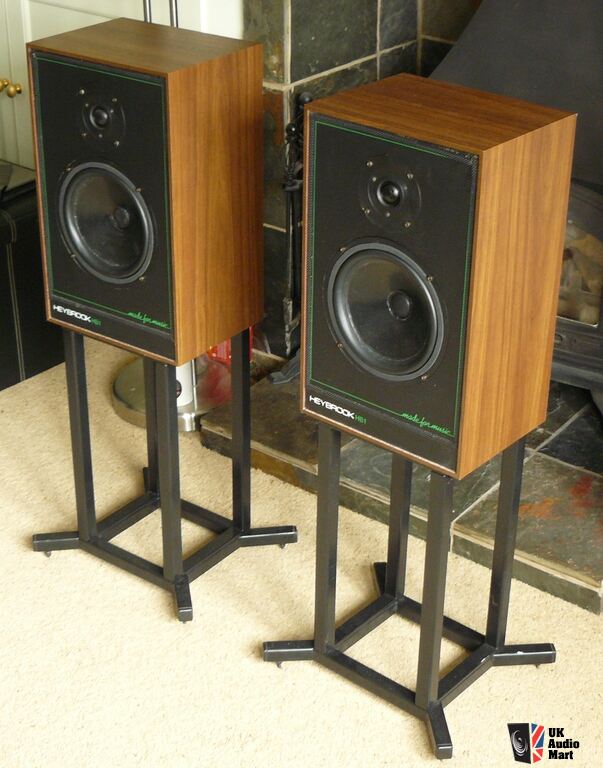
I was managing a hi-fi shop in Plymouth when Stuart Mee walked in and asked me if I had any speakers better than his Celestion Ditton 15s. Actually the usual small speaker I was recommending was the Videotone Minimax and, good though it was, it didn’t win over the Celestions. So, we entered into a discussion about why there weren’t any really good bookshelf speakers under £200. Based on my kit speaker experience, and knowledge gained from a Gilbert Briggs Loudspeaker book, we thought we would have a go at designing something that satisfied both of us. After about 18 months of experimenting, and a lot of discovery and learning about cabinets, drive units and crossovers, we had our first prototype. It was so good that we realised it would sell really well, and that was the basis of the Heybrook HB2.
Heybrook really took off, in terms of turnover, with the HB1 speaker, the first of my designs to win three What Hi-Fi Awards in consecutive years. My friend, Shane White, developed a prototype turntable which we refined and turned into the Heybrook TT2 and I worked with Tim de Paravicini on some amplifier designs. Along the way I had a lot of fun designing speakers like the Sextet - altogether it was 15 years of extremely hard work and a lot of design exploration, learning and enjoyment.
After Heybrook, did you go into freelance speaker design and go back into reviewing?
Eventually Heybrook grew to the point where I was spending more time in administration than design and development, so I made the decision to sell out. That left me free to do speaker consultancy work with a sideline reviewing, as consultant editor, for Hi-Fi News magazine and I also expanded my fascination with computers and IT by writing for computer magazines.
What was your initial remit when you joined Mission?
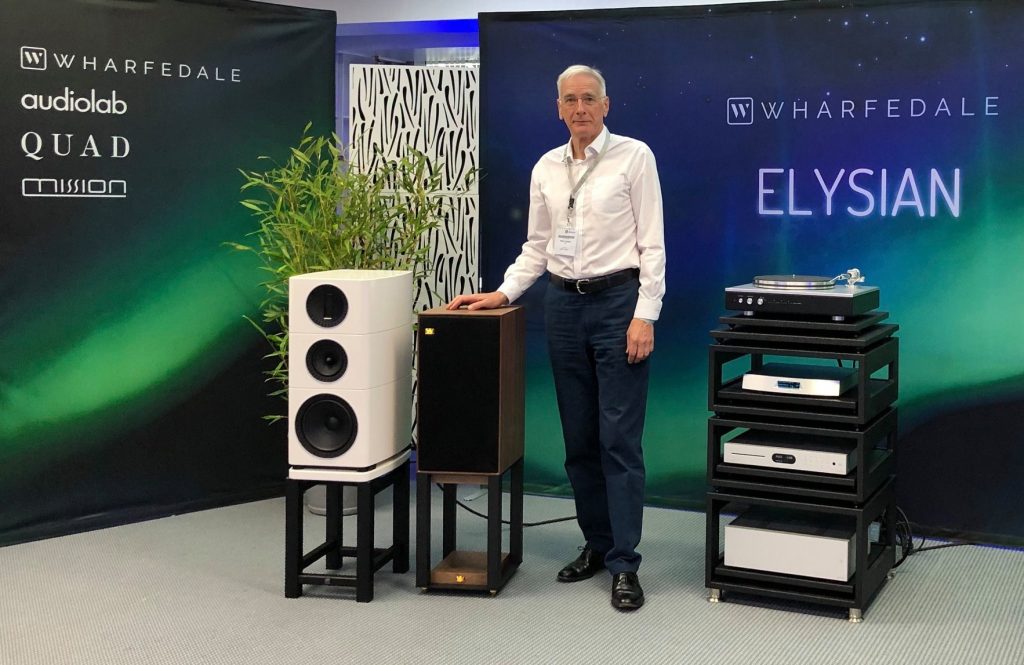
I’d done a lot of consultancy work with NXT (Mission’s flat speaker technology offshoot) so, when the speaker design engineer vacancy appeared at Mission, they asked me to come and work in Huntingdon. Mission were well known for popular, award winning affordable speakers and their customer base was completely in accord with what I loved doing which was making small speakers which sounded lively and musically inspiring. I made some mods to their best selling range, which turned into the 77e series, and those immediately got universal 5 star reviews. My first clean-sheet design, though, was the 780 which, like the HB1, won 3 consecutive years of What Hi-Fi Awards. I’m still enjoying designing and making great sounding speakers for Mission today.
You have been involved in reintroducing old models that have been brought up to date. (E.g Wharfedale Lintons, Mission 770 etc) Was this totally your idea?
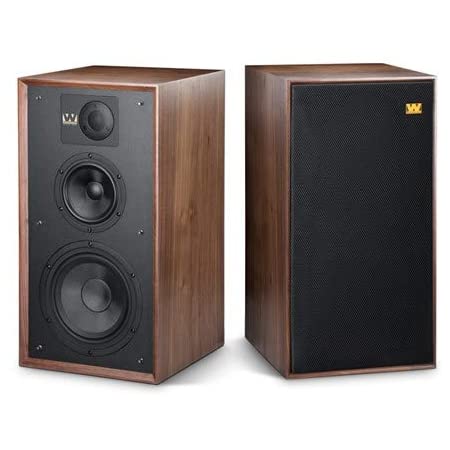
It started with an idea I had for an anniversary model for Wharfedale. Looking back over 80 years of Wharfedale history, the best selling models were the Denton and Linton. The original Industrial Design of these was so good that I felt it would still look great in people’s homes today, so we started with the Denton to see what people’s reaction would be. It sold so well that I really wanted to bring the Linton up to date too. The marketing people were worried that it would be too big to sell well but, actually, it has turned, once again, into Wharfedale’s best selling speaker.
As I’ve often pointed out, larger speaker cabinets with bigger bass units make the speaker designer’s task so much easier and do a better job of delivering full scale musical reproduction in the home. Clearly customers have reacted positively to this and it has resulted in other brands dusting off some of their vintage designs too!
What, in your opinion, makes the Mission 700 & 770 speakers so good?
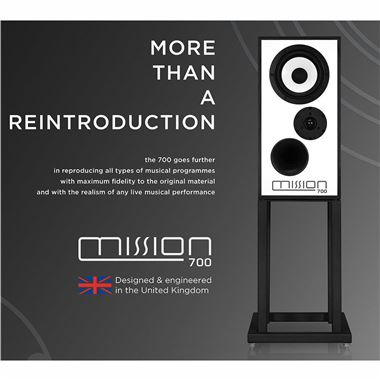
Well, the 770 is still a classic speaker. If you are lucky enough to get hold of a pair of the original 770s today you’ll be surprised at how good they still sound. Sure, a reviewer would criticise the slightly unruly bass and some steeliness in the treble performance, but the midrange is magical. I wanted so much to recreate that midrange performance but upgrade the bass and treble to match, as well as to suit modern recordings and digital sources, that I spent two and a half years developing and refining the new 770, building a total of 174 prototypes until I was happy.Both the original 770, and the very first 700 design, featured that magical midrange which captured your attention and made you want to play record after record late into the night. I’ve just read a neuroscience analysis of music which explains that the first thing we latch on to, as toddlers, is rhythm. What these speakers do is present musical rhythm, as well as natural instrumental and vocal detail, in a really infectious way. I’ve got the new 700s in my lounge at home and I love seeing people’s reaction when I play some music to them. There’s a sort of instant feeling of musical satisfaction that brings a smile to their faces and gets their toes tapping and bodies moving. Isn’t that what hi-fi should be all about?
Some 20 plus years ago, you released a high end Mission speaker called the Pilastro (which was absolutely superb). What are thoughts on that speaker now? Would you want to bring out a newer version to the market?
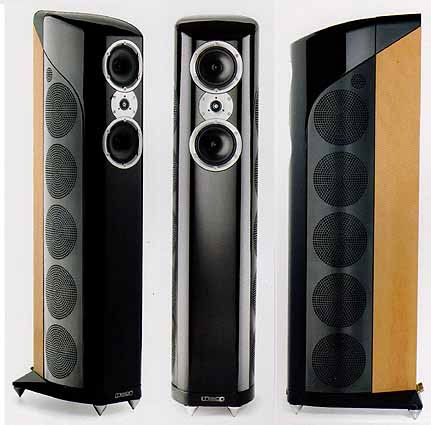
Funnily enough a German reviewer came up to me at the recent Munich show and told me Pilastro was still his favourite speaker. I’ve also made friends with a guy in Norfolk who has collected three pairs, he loves them so much. It’s a great speaker that probably works better today than it did when it was first launched simply because amplifiers and recordings and sources are now so much better they show what the Pilastro can do. It was an expensive speaker at the time and it would venture into the ultra high-end to recreate a new version now and I’m not sure Mission has the distribution clout to handle that, but it would sure be fun to try.
Pilastro is one of the very best speakers I've ever heard. Without a shadow of a doubt. Do you prefer to work on High end speakers designs or more real world priced designs?
It may seem odd but I just love designing speakers that people can afford. To know that tens of thousands of people world-wide are using my speaker designs to enjoy music to its utmost in their homes is very gratifying. Sure, it’s lovely to have the budget and resources to push the boundaries of speaker design with higher-end products, but I’m not in accord with the ultra high-end where you might end up making 100 pairs a year if you’re lucky. Wharfedale Elysian was a lot of fun to design and is probably my most expensive, popular speaker but we will still sell upwards of a thousand pairs.
What is the most important thing for you when you design a speaker?
Getting the music across to the listener in a totally engaging way, first and foremost, as well as helping you believe that you are listening to real musicians. To do that you have to make sure the rhythmic structure is presented intact and that the tonal balance is natural and that you can hear through the speakers to the musical performance. To do that you have to make sure that the fundamentals and overtones of instruments and vocals are in balance, which is more tricky than you might think. Although I use measurements and computer prediction and analysis in the early stages, the real work comes from hours and hours of listening, tinkering and fine tuning. During this period I’m making adjustments that are difficult to measure but are clearly audible.I also think that speakers should be a relatively easy load for the amplifier. I’ve no idea what amps people are going to use with my speakers, so I avoid demanding loads which have ridiculously low impedances or violent swings between capacitance and inductance as you sweep through the frequency bandwidth.
With the success of the recent Wharfedale & Mission speakers, are there any plans for other revised versions of classic models?

Why not? There are some great favourites from the past which I’d love to bring up to date.
What are your all-time favourite pieces of hifi? (Speakers & other items)
I would class all-time favourites as the ones that I continue to enjoy, so QUAD Electrostatics are still on that list and every time I’ve heard the top-of-the-range MBL Radialstrahle 101 system I’m in awe of the way it immerses you in the musical experience. For turntables I’m still a fan of the Garrard 401 (in a slate plinth) but recently found that the new Thorens DD version of the TD124 can produce much the same performance. For modern amplifiers I’ve recently been using the Audiolab 9000A a lot and can’t fault it and for a source I’m a big fan of using Qobuz via Roon through my MacBook Pro though the Lumin U2 is on my shopping list. My favourite amplifiers tend to be valve based and I still have a fondness for the Radford STA25.
Having made a great sounding turntable (Heybrook TT2), have you ever considered revising that for today's market?
Not really but if I did I’d probably make it Direct Drive!
Do you think HiFi has got better, over the last 40 years?
Definitely. It’s hard to quantify when you look back and try and remember what music in the home was like 40 years ago because a good system was as enjoyable back then as it is now. But when you actually take some of the equipment that I loved back in the late ‘70s and early ‘80s and put it up against what is being designed now, it’s obvious how well-designed modern equipment just makes music sound more real. With a careful setup of even a moderately priced system it is possible to make the hi-fi disappear so that all you’re aware of is the musicians in the room. That was much more difficult to achieve 40 years ago.
When you were with Heybrook, you tried to make active speakers popular. What are you thoughts on active speakers today? Why do you think they are not as popular in the HiFi market?
The Hi-Fi market is often quite conservative in its likes and dislikes. Whilst the rest of the market is gobbling up networked smart speakers, Hi-Fi buyers still seem to prefer the three unit system of source, amplifier and passive speakers. I’ve no objection to this as I feel that passive crossovers are more easy to mould to the requirements of real world drive units. For active speakers the drive units really need to be as perfect as you can make them, because it is more difficult to tailor the electronic circuits to achieve the acoustic crossover slopes that you need. As DSP, so-called Class D amplifiers and drive units get better I can see a future where active speakers really will start sounding superior plus, of course, you can build all the required networking into them.
However, the market uptake is going to be slow. In one way you’re depriving the customer of choosing what type of amplifier they want to use - designing an active speaker crossover and amplifier using valves, for example, would be wasteful of resources and energy consumption. I think it’s best to consider a system approach where everything is properly matched and simple to network and is easy to use. But then you’re depriving the customer of choice - putting together a traditional system is quite a lot of fun for the audiophile.
Do you think you will revisit active speakers in the future?
I have already started. Mission LX Connect was fun to design and provides a plug-and-play, hi-fi quality, true wireless stereo system at a moderate price. But, in a way, it’s perhaps too close to the smart speaker end of the market. Maybe something more sophisticated in performance at a higher price would sell better? I’m often broaching this subject with the marketing department.
Loudspeaker technology seems very well established. It has been refined but perhaps not “shaken up”, what can you see happening in domestic loudspeaker design in the future?
Again, I think we’re battling against what is a traditional market when we try and introduce new concepts. People get all excited about new technologies but the fact is that they take many years to mature before we begin to see/hear the true benefits. We’re still making better and better moving coil drive units through our understanding of the causes of resonance, coloration and distortion. And we’ve found out how to refine and improve tried and tested technologies like ribbon and AMT treble units. I think that process will continue for some time.What I’ve always tried to do is to make speakers that work well in a variety of homes. Most audiophiles, reviewers and hi-fi retailers think that speakers sound best spaced well away from walls and corners whereas, when I see the pictures that a lot of customers post on social media, speakers are often pushed back against the wall or into corners. I’ve done it before and would like to do it again and that is to design speakers that you can integrate into walls or corners. That’s not a new idea, Gilbert Briggs and Peter Walker advocated corner speakers in the mono days and Roy Allison did a lot of designs that worked against walls. It might not suit the die-hard audiophile but I do think it is one way forward to achieving a more predictable performance in the listener’s home environment.
What new developments are you working on?
I’m always trying to make things better by simplifying them. For example we’ve come to think that cabinets need to be heavily braced in order to make them inert. But the fact is that you can’t really make a wood cabinet totally inert, you’re just shifting panel resonances around. We could make mineral loaded resin cabinets like Pilastro, but veneered wood has a lot of appeal when you consider that speakers are viewed as items of furniture in the home. Now that we have the technology to analyse cabinet behaviour we’re exploring superior methods of controlling cabinet resonance so that it doesn’t affect the musicality of the speaker. This understanding of which resonances and distortions interfere with the music and which ones don’t can also be applied to everything from drive units to amplifier circuits. It’s all part of the continuous development of making systems sound uncannily real and thoroughly enjoyable.
Peter ComeauDirector of Acoustic DesignIAG Group Ltd

Thank you Peter for your excellence in loudspeaker design and for taking the time to discuss your career with us.
